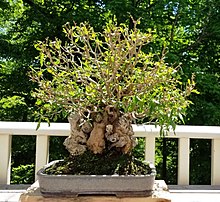Cultivation and care[edit]
Material sources[edit]
All bonsai start with a specimen of source material, a plant that the grower wishes to train into bonsai form. Bonsai practice is an unusual form of plant cultivation in that growth from seeds is rarely used to obtain source material. To display the characteristic aged appearance of a bonsai within a reasonable time, the source plant is often mature or at least partially grown when the bonsai creator begins work. Sources of bonsai material include:
- Propagation from a source tree through cuttings or layering.[51]
- Nursery stock directly from a nursery, or from a garden centre or similar resale establishment.[52]
- Commercial bonsai growers, which, in general, sell mature specimens that display bonsai aesthetic qualities already.[53]
- Collecting suitable bonsai material in its original wild situation, successfully moving it, and replanting it in a container for development as bonsai. These trees are called yamadori and are often the most expensive and prized of all Bonsai.[54]
You received this message because you are subscribed to the Google Groups "1TopReadys1" group.
To unsubscribe from this group and stop receiving emails from it, send an email to 1topreadys1+unsubscribe@googlegroups.com.
To view this discussion on the web visit https://groups.google.com/d/msgid/1topreadys1/CAL9GL%3DmdTCfb%3D%2B%2BgJUgz3J%2BPGeNUdSM5T9ONkwhy83_S0qn2oA%40mail.gmail.com.

No comments:
Post a Comment